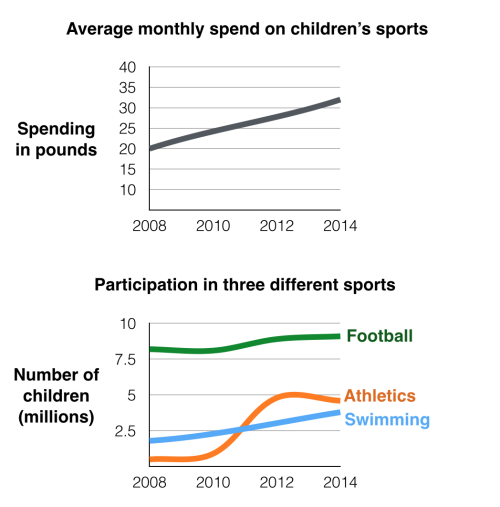雅思写作小作文范文 雅思写作折线图(线状图)英国孩子运动
今天我们雅思写作小作文范文的文章来研究下折线图(线状图)。第一张图表的内容为2008年和2014年间,英国家长在他们孩子的运动上所花费的金钱。第二张图表展示了在同样的时间段里参与三种运动的英国孩子的数量。该题目虽然由两张图表组成,但均为折线图,同时图形也比较简单。老烤鸭小编搜集了一篇相关的考官范文,以供大家参考。
雅思写作小作文题目
The first chart below gives information about the money spent by British parents on their children’s sports between 2008 and 2014. The second chart shows the number of children who participated in three sports in Britain over the same time period.
Summarise the information by selecting and reporting the main features, and make comparisons where relevant.

雅思写作小作文范文
The line graphs show the average monthly amount that parents in Britain spent on their children’s sporting activities and the number of British children who took part in three different sports from 2008 to 2014.
线状图展示了英国父母在他们孩子的体育活动上平均每月所花费的金钱,以及从2008年到2014年之间,参与三种不同活动的英国孩子的数量。
It is clear that parents spent more money each year on their children’s participation in sports over the six-year period. In terms of the number of children taking part, football was significantly more popular than athletics and swimming.
很明显,在六年的时间里,父母每年在他们孩子参与运动上所花的钱越来越多。至于孩子所参与的运动,足球要比体操和游泳明显更受欢迎。
In 2008, British parents spent an average of around £20 per month on their children’s sporting activities. Parents’ spending on children’s sports increased gradually over the following six years, and by 2014 the average monthly amount had risen to just over £30.
2008年,英国父母在他们孩子的体育活动上平均每月花费大约20英镑。在接下来六年的时间里,父母在孩子运动上的花费逐渐增减。到2014年,平均每月的花费已经超过了30英镑。
Looking at participation numbers, in 2008 approximately 8 million British children played football, while only 2 million children were enrolled in swimming clubs and less than 1 million practiced athletics. The figures for football participation remained relatively stable over the following 6 years. By contrast, participation in swimming almost doubled, to nearly 4 million children, and there was a near fivefold increase in the number of children doing athletics.
再来看看参与度。2008年,大约800万英国儿童踢足球,而只有200万的孩子参加游泳俱乐部,练习体操的孩子还不到100万。在接下来的六年里,踢足球的孩子的数量基本保持不变。相比之下,选择游泳的儿童的数量几乎翻倍,达到将近400万。而练习体操的孩子的数量则有将近五倍的增长。
点击查看雅思写作小作文高分范文,快速提升写作成绩


